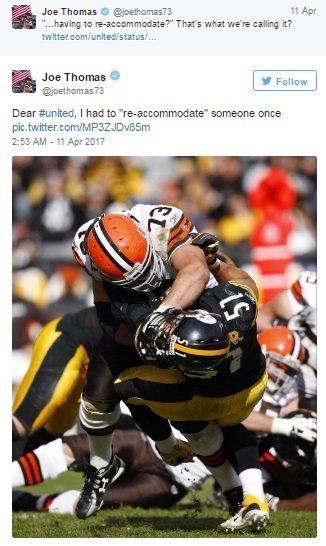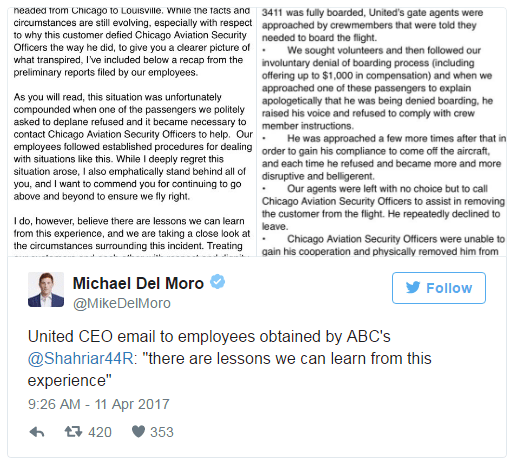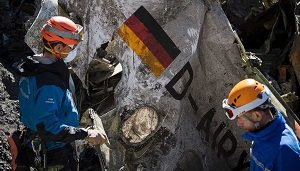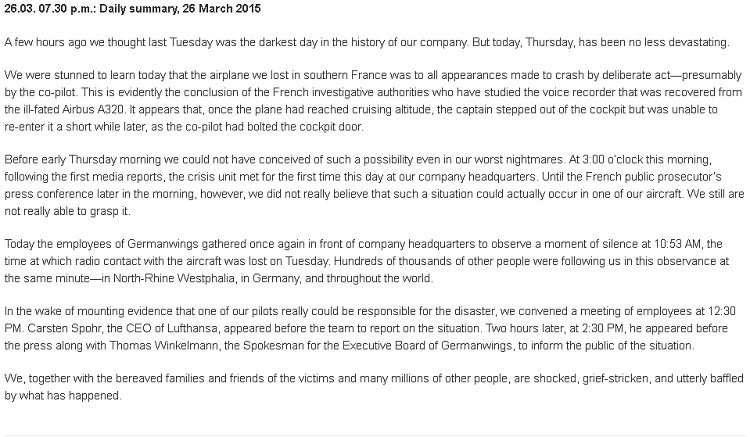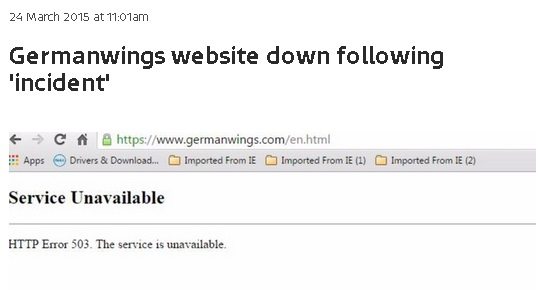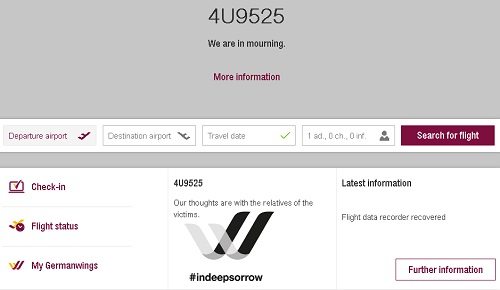Nailing Your Crisis Media Conference with Doug Weller
Date: 18 November 2021
Format: Online Webinar
Presenter: Doug Weller
LinkedIn Registered Guests: https://www.linkedin.com/events/10tipsformediaconferences1pmwed6855024735483523072
Video Recording on YouTube: Nailing Your Crisis Media Conference with Doug Weller from Corporate Media Services (and below)
PowerPoint Slides: Nailing Your Crisis Media Conference with Doug Weller from Corporate Media Services (and below)
Say Thank You with an Informative Review: Google or Website
If you have any further questions about crisis media conferences, communications or media training, please contact us.
Webinar Transcript
Hello and welcome to our webinar today – Nailing your Crisis Media Conference. My name is Doug Weller, I am the Director of Corporate Media Services and I’ll be your host, your facilitator today. Just some housekeeping before we start. I’ll be going between some slides and also some video clips today. I won’t go full screen with the slides today as I find when I go full screen in our media training sessions, then I go into those video clips sometimes it can actually freeze the system so the slides will be almost full screen today. Everybody will be able to see them okay. You’ll see the slides off to one side and the video clips are off to the other side. OK let me share the screen
I’d like to start by acknowledging the traditional owners of the land on which we meet today. I’d also like to pay my respects to elders past present and emerging
So Nailing Your Crisis Media Conference. I’ll have a presentation first up and then I’ve got time for some questions at the end. I’ll be using the COVID-19 media conferences as examples today. We’ve seen these media conferences being rolled out on a daily basis over the last 20 months and there’s a lot we can learn from these media conferences. After today perhaps review one of these media conferences or a couple of them – sit down with your leadership team and see what sort of processes you could take away from this to roll into your particular situation. When you’ve got a crisis, and every media situation is different, always seek professional communications and legal advice before dealing with journalists and the media your communications people your your media people and your lawyers will keep you safe you need to be absolutely firm and clear and confident about the messages you are delivering in a crisis situation and your lawyers and your Comms people will get you to the right spot.
OK about your facilitator today – so I’ve been involved in the media industry for more than four decades – kicked off as a cadet in commercial radio and TV. After that I went to the ABC – I was at the ABC for 13 years. While I was at the ABC I was posted to Washington where I was the ABC’s Washington Correspondent where I covered the White House, the State Department and of course, The Pentagon and other issues in America at the time. Came back to Australia and was posted to the Canberra press gallery after that went to Melbourne where I fronted the first morning TV news and current affairs program called First Edition with the wonderful Kate Dunstan after the ABC I went to RMIT University in Melbourne whereI lectured in TV Journalism and after eight years I left RMIT to start up this company Corporate Media Services and what a great segway into talking about Corporate Media Services.
So we run training courses throughout Australia and the South Pacific – Media Spokesperson training – getting people to the right spot so they can talk definitely and proudly of their positive media situations and also dealing with those tough issues as they come along. Executive Media Training where we step it up a little because Executives do come up against tougher issues. Crisis Media Communications training and that’s part of what we’re talking about today – Nailing your Crisis Media Conference. We also run Presentation Skills training and Public Speaking training. Our courses are customized – they have to be customised – every situation is different for every client and they are highly interactive so we get people up very quickly in front of the cameras – in front of recorders doing the interviews, replaying, unpacking, giving feedback. So more than 80% of our courses are interactive where people are really moving through those interview processes because that’s where the learning happens with adults.
All right – you need a plan – you need a strategy obviously when you’re dealing with a crisis situation. If you have a crisis so serious that media turns up generally unannounced in the car park at the front gate and all of a sudden – do you go out and front the media in that particular situation? So what you need to do is do most of the work now – most of the planning now so you formulate a strategy – you formulate a plan and part of that really crucial is your Crisis Communications Team. Who is going to be the the team on the day that’s going to assist you in this particular situation. That needs to be established now. Look at those likely incidents that could occur in your organization. Every organisation is different. You would know the top three, six, ten things that could go wrong in your organisation which would mean, so serious, would mean media turning up in the car park, at the front door, at the front gate. Have a look at those incidents and start thinking about how you would respond to that. Start thinking about the messages you would deliver in a situation like that and do as much work as you possibly can now.
So as I say there – anticipate questions, prepare your messages and your holding statements now the best you can. On the day you might need to adjust them and that’s absolutely fine but do as much work as you possibly can now – sitting down with your leadership team, your communications people, your lawyers, so everybody has done a lot of work on those messages before you actually have to go into the situation to prepare quickly for this crisis media conference. Prepare your other communication channels now – social media – really important part of the process, not only in crisis communications, but in all communications. You’ll need a specialist social media team looking at those social media situations. Are you going to be releasing a statement through your social media situations? Is there going to be some activity as far as social media is concerned? Do you need to respond to that so social media obviously a very important part of the process and your social media specialists – your team members – they’ll be part of that crisis communications team, and also look at your other communication channels – your website, your various other communication situations.
Keep the media informed and who will take those media calls when they come in. Generally that’s going to be a communications person, a media person within your organisation. If you don’t have a communications or media person, decide now who will take those calls. You need to keep the media informed. Are you just releasing a statement or are you going to be fronting the media that’s gathering outside? You need to let the media know exactly what is going on. Unexpected door stop protocols – making sure that people understand what to do if they are approached by media as they roll up to your site or as they they come up to to work in the car park. I had an executive say to me once what would I do if all of a sudden there’s a crisis within my organization – Ii get to the car park and media swarm me? Well that’s quite simple you act in a very calm and professional way. You don’t give any comment, you direct the the media to the comms person, or you go inside and tell the comms person could they please come out and deal with the media. But everybody needs to know exactly what to do. Is your spokesperson trained and do you have backup and you’re probably thinking, well Doug you’re a media trainer of course you’re going to say that, but really I think you need about three or four, possibly five people who are ready to roll in a situation like this. The boss may not be there. He or she might be overseas – second in charge may not be there – you may have some situation where the third person is unable to do it, so you need a team of people who are ready to roll. Yes you’ll have your primary spokes people but you’ll really need a backup to make sure that you have people who are ready to roll on on a day when they have to go out and front a crisis media conference.
Pick a safe media point this is really important making sure that you find a quiet safe area, generally outside so your media spokesperson can walk out of the building, up to the media, deliver the messages and when they decide it’s time to go – we’ve decided beforehand when it’s time to go – retreat to the building. I faced a situation years ago when I went to a press conference like this. Everything was well organised. The communication processes were good. The media was being told what was going on. The spokesperson came out – everything was fine but it he walked up to the media and the sun was in his eyes and that caused him a great deal of difficulty in terms of delivering those messages. So everything else was organised but the sun was in this person’s eyes and that caused a problem. Still went through the media conference situation but you could see this person was very uncomfortable. So you’ve really got to think about these media points and making sure that they are nice and safe and comfortable for the spokesperson.
How long will the spokesperson stay? Are you simply going to deliver a statement and then the spokesperson makes an exit? Are you going to have a situation where you’ll deliver a statement and then take a few questions? Sometimes people walk out and they simply take questions. This all needs to be decided by the Crisis Communications Team beforehand so the spokesperson on the day – she or he knows exactly what they need to do in any given situation. It’s not a case of going out and thinking we’ll see how this goes. It needs to follow a very very definite plan all worked out before the spokesperson comes out and delivers the messages to the media. You need to have your spokespeople in a situation where they’re really clear in terms of what they need to do you – need to have their confidence high and their fear low. It’s very hard going out and walking up to a whole bunch of journos and and delivering messages or reading a statement, so you need to have your spokesperson empowered so their confidence is high and their fear is low and that’s the spokesperson having an understanding of a very clear plan in terms of dealing with this very difficult situation.
Seamless entry and exit – very important that you don’t have your spokespeople battling through the media scrum to get to the front, and battling through the media to get back out of the room. You will not see, nor should you see, with the crisis media conferences at COVID-19 media conferences, you will not see Premiers, senior health officials, anybody battling through the media to get to the to the front of the room and battling back out as as they leave. It’s going to be a seamless process entry and exit and I want to show you some examples now. OK let’s have a look at New South Wales
So I’ll just stop it there to make a point. You see the Premier is coming out. It’s going to be a clear entry then a clear exit. He’s waiting for his team to come out and stand behind him. He’s not in a hurry. Big mistake people make in these situations – they come out and they start delivering messages from around about three meters away from the microphones – no – there is no rush. He comes out he stands there, has a final look at his notes and wait for his team to gather behind him.
“Well good morning everyone – it’s great to be here with half the cabinet” OK and then he starts. So let’s have a look a similar situation in Queensland and you’ll see Annastacia Palaszczuk coming out, the team following her out and you can see where where she enters the room and that’s where she will exit the room.
“All right good afternoon everybody. OK good afternoon Queensland”
And then away we go. So clear entry clear/exit. Let’s have a look at Daniel Andrews and there’s something that Daniel Andrews does in addition here which I want to speak about.
“Everyone right to go?” okay okay I’ll just play that again “everyone right to go”
All right so sometimes people say this, sometimes they don’t. It’s not a mistake if you don’t say it but i think it’s a very good thing to do. You’ve got a lot of journalists there, you’ve got a lot of equipment and sometimes things go wrong and when somebody says “is everybody right to go” sometimes they’re not and it allows the the journalist or the camera person to say “oh no can you just hold on a few a few moment we have to fix an issue that we’ve got” You want to make sure that everybody is right to go. The media wants to make sure they’re getting all your messages and if you’re going out to front a media conference you want to make sure that you’re getting your messages across to absolutely everybody so by saying is everybody right to go, it’s courteous and you don’t get too many courteous moments as a journal or a camera person on the road so i think it’s a courteous thing to do. But it also has sent a message to me as a journalist when this has happened that this person is very confident in the space they know what they’re doing in terms of the media and so it sends a really good message. So don’t be afraid to walk out and say is everybody right to go – gives you a bit more time to actually get settled and then away you go. It’s not a mistake if you don’t do it, but I think it’s a very good addition to the process. But the what I was trying to get across in those three clips – clear entry clear exit – nobody’s in a hurry – everybody’s getting getting settled and then away we go.
So I’ll just share the screen again. Your audience. The all-important audience. Use the media to deliver your messages to your audience and identify your internal and external audiences now because once you’ve worked that out then you can start looking at the wording as far as your messages are concerned. You want to make sure that those messages are connecting with the audience you are after and we all have different audiences and you know who your audience is going to be – various stakeholders, government organisations, business groups, staff, family, local residents. So think think now about the audience and then start pulling those messages together.
The messages – the all-important messages. So get on the front foot quickly now. There’s a lot of research out there – some people say you’ve got 15 minutes to get messages out in a crisis – some people say you’ve got half an hour or an hour. What you need to do is try to get your messages out as quickly as possible to get on the front foot as quickly as possible, but you don’t send your spokesperson out to front of media conference until they are absolutely ready to go. So the whole idea pulling together as much as you possibly can beforehand allows you to get out there quickly. But you only send a spokesperson out. You only send your messages out – your statements – out when you’re absolutely happy with those statements – those messages and the spokesperson is feeling absolutely empowered.
So what are you going to do in terms of messages? Confirm the incident – I mean what do we want when we roll up to a situation like this as far as media is concerned? We want confirmation what actually happened. Journalists will be chasing the who, what, when, where, why, how – well you may not have all of that information but hopefully you can actually confirm what’s actually occurred when you start delivering the messages. Empathy first and every single time. You may need to offer condolences – hopefully you won’t. You will have seen with the covert 19 media conferences, every single time because unfortunately peaceful people are passing away from COVID, condolences at the beginning of the media conference and this is absolutely and totally appropriate. Then clear concise jargon free messages or a statement – honest transparent and genuine. So I want to show you this example from South Australia. This is the Senior Health Officer Professor Nicola Spurrier coming out on a day – very tough day. South Australia are about to go into a lock down but really clear about the messages. Really clear in terms of delivering those messages and doing it in a very definite way and the Professor paints a picture so we all understand very clearly what we need to do in terms of the situation on this day so let me let me play this one:
‘Thank you and good morning. Yes a worrying situation here in
South Australia and just to reiterate the really important point for people who are watching this press conference. This is the time to stay put. This is the time not to move around. The virus doesn’t have legs. It moves around when people move around. So if we stay put the virus will stop and we’ll be able to get on top of it. So that’s really one of my my main messages today and the second is – if you’ve got any symptoms whatsoever go and get tested because that’s how we’re going to be able to know if the virus is spreading’
OK so what I love about that – clear, definite paints a picture – the virus doesn’t have legs – it moves around when people move around. ‘This is my major message here today’ and really if that’s the only thing that is used in terms of a grab or a sound bite or a quote – if it’s not going out live most media situations are going to be quotes grabs and sound bites – if that’s the only things it’s used – that’s a wonderful use of media. So that’s what I mean in terms of clear concise understandable messages. I’ve got some other messages here that people might like to consider when they’re dealing with these very tough situations. These are messages that I’ve pulled together over the last 18 months or so when I’ve been helping clients deal with crisis situations involving COVID many times. So confirmation that the incident has occurred, expressing empathy, concern for those people who have been impacted. Working with, and taking direction from the authorities – if it’s a covert situation from the Health Department um constantly in touch with the authorities or with the Health Department to make sure that we’re following the appropriate protocols. Keeping everybody informed the best we can and finding out what’s actually occurred so we can rectify the situation to try and make sure it doesn’t happen again in the future. So that’s a set of messages that you can possibly look at when you’re looking at messages that you would want to deliver in these very difficult situations. But again every situation is different. Every crisis situation is different. Your messages are going to be different but that might just be a good starting point. OK let me go and share the screen again.
So don’t get involved with hypotheticals and don’t speculate, even if journalists are trying to draw you into that space. You are – you are very clear on the messages that you are going to be delivering. You’re following the plan that you’ve worked out with your your team and you do not get into hypotheticals or speculation and you certainly don’t go off the record. If somebody asks you an off the record – a question at the end of the media conference – no – everything needs to be on the record. So as I say there – control and deliver the message then stop. The grab, the sound bite, the quote, whatever you want to call it, so deliver it and then stop. So you need to go through an out-loud rehearsal. As I say down the bottom there with your team beforehand – to get you to that point where you’re delivering those clear concise messages, delivering the message then stopping because confidence is the key in all of this. Most of the people we have in our Media Training, our Crisis Media Training courses – they’re leaders in their particular area they’re experts in their particular area. They’ve got good communication skills. It’s a case of getting them to the point where they need to be, to deliver these messages in this very difficult crisis media situation. And I’ve got there – ‘own your words’. Journalists from any situation – in any situation, will toss words at you and if you toss them back – you own them. You take ownership of those words. Now if it’s a live interview, that’s OK. People hear these things in context – if it’s not we don’t hear the journalist’s question, or see the journalists question – all of a sudden you’ve taken ownership of that particular word and you may not actually want to do that so making sure that you’re delivering your words – not words that have been tossed at you in the the heat of the the crisis media conference
So this is a process which is used around the world. Emergency services organisations often use this when they’re pulling together messages, and it’s a great. What I call four-point message guide. This is what we know, this is what we don’t know, this is what we’re doing and this is what we want you to do – a call to action. So you won’t get a question from a journalist – do I have a call to action today – you need to take yourself to that call to action and that is the bridging process. Using what we call bridging phrases so at some stage in that media conference, if you have a call to action you need to take yourself there. Look can I just say this, could I just add this one thing I’d like to ask of the residents, one thing I’d like to ask of the of the public – it’s a call to action. And we often see calls to action with emergency organisations when they have an incident. And we’ve had endless calls to action over the last 20 months with these COVID-19 media conferences start it off with washing our hands, don’t touch your face, stay at home, social distancing and then follow the rules. We’ve got restrictions in place – follow the rules and what are we getting now – get vaccinated – get vaccinated – get vaccinated – these are calls to action. You don’t have to have a call to action when you’re pulling together the messages but you can deliver a call to action. But a journalist isn’t going to ask you do you have a ‘call to action’ you need to be in a good head space to be able to just roll that out and take control of that particular situation.
All right looking the part this is, in a lot of ways, common sense. But it’s something that people actually forget on the day. People are so focused on the messages – they’re so focused on looking at the media outside and feeling a bit uptight about that – lots of conversations going on – doing the out loud rehearsals and sometimes they just forget that the collar’s not quite right or the jacket’s not quite right so it’s a pretty easy fix. You simply turn around to your communications team or the communications team gets the spokesperson before they go out and just goes okay, yep this is all this is all good – this is appropriate or you go to the bathroom and you have a look in the mirror to make sure everything is nice and neat and tidy. People say well what should I actually be wearing in a situation like this? You decide on the day. What we’ve been seeing with the COVID media conferences – everything from plain business attire through to smart casual – all of it’s been appropriate. Should you wear a high visibility vest if the situation calls for a high vis vest? Safety gear – absolutely, but making sure that you take advice on that because you don’t want to be wearing a high vis vest that’s not appropriate. Try to avoid transition glasses and definitely no sunglasses. I’ve had a number of communications people say to me over the last 12 months why does the U.S President Joe Biden wear sunglasses when he’s speaking to the media and I have absolutely no idea. I’ve read a couple of articles which said that he likes his sunglasses – it’s not a good look so try to avoid those transition glasses and definitely no sunglasses.
OK the media conference. So the spokesperson must calm themselves before going out and there’s a range of ways that people do this. Sometimes people get all the messages together – they’ve done the out loud rehearsals – they’re feeling fine – they’ll go outside, stand in the sun for a little bit. I’ve seen people go into a room where they put all the messages out in front of them on the on the carpet and they just look at them for a few minutes to absorb all of that information. So just calm yourself beforehand, being absolutely clear about the messages that you are going to deliver and then you arrive with authority. And I showed you those examples a little earlier. Deliver your messages and deliver them well and that’s what we saw with the Professor earlier. The major issue at the moment is be very firm about delivering those messages, making sure that you are telling the audience, if it’s going live, what those major messages are. And you’re telling the journalists that are there these are the major messages, and if journalists understand the major messages on the day that’s probably what they’re going to run. As far as quotes grabs and sound bites, if you don’t know the answer – be honest. One of the most refreshing things to come out of these COVID-19 media conferences is that when when a Premier or a health official, or a Health Minister doesn’t know the information, doesn’t know the answer to the question, they’re completely honest about it – ‘Look I’m not sure about that – that’s a good question we’ll get back to you on that – what I can tell you, what I can say, what I can put across’ So don’t feel as though you need to know absolutely everything about everything especially in the early part of a crisis situation. Just be honest and upfront – ‘Look I don’t know about that – we will find out about that, but what I can tell you, what I can offer you’ Correct any misinformation that’s floating out there on, you know, on radio or in social media. Again journalists won’t ask you would you like to correct any misinformation – you need to take yourself there. The spokesperson needs to be empowered to go to that point ‘Look I’d like to actually correct some misinformation that is out there on social media’ and then away you go. Maintaining solid eye contact, and I’ll come back to that. And then you need to depart with authority. Let me show you this example from Tasmania of a nice definite departure situation – ‘Information they provide us with, I think the evidence of how they’ve been prepared to cooperate with us is very clear for everyone to see and that cooperation hasn’t been forthcoming’
So there you go, so nice definite exit, clear entry, clear exit – you’ll see it every single time with these COVID media conferences and that’s exactly how it should actually happen. As far as the eye contact is concerned, it’s important that we see you looking at a journalist or looking at all of the the journalists. People who deal with media a lot, so senior business people, politicians, sometimes they will actually come out and say once they’ve said ‘is everybody right to go’, then they’ll say ‘where would you like me to look’ and what journalists will do, they’ll say can you look at that person in the middle and that’ll allow all of the cameras to get a good look at the front of you. So this is sometimes a bit difficult if you don’t do it a lot. What some people do they they actually get one of their team just stand behind that journalist so the spokesperson has a friendly face to look at – not suggesting for a moment that journalists aren’t friendly, but that’s what they do. But again this is this is something that happens when people deal with the media a lot. I think it’s a hard thing to do if you don’t do a lot of media so my recommendation is just look at the journalist who is asking you that question and engage with that journalist or look around at all of the journalists and you’ll see this with the COVID media conferences. They’re either looking straight at the journalist asking the question quite often, or they’re looking around the room. Just one final issue with all of this, just to make it a little bit more complex – if you are actually looking at the journalist and dealing with that particular journalist, and the journalist over there has asked a question and looking that way, the TV cameras won’t be able to get your face over here. They’ll get the back of your head and that doesn’t work for TV situations. So you may find a journalist, once you’ve answered that question, a journalist over here saying oh could you answer that again, or they’ll ask a similar question to get you to look that way, to deliver the message that way, and that’s absolutely fine – just just repeat the message.
All right some final points. Remove the phone. You don’t need your phone going off obviously in the middle of a media conference – especially a crisis media conference. Don’t confuse the message. Make sure the messages are as clear and understandable as possible. We’ve seen some confusion with the messages with the COVID situation making sure that you’re not confusing the messages.
Don’t deliver throw away lines as you walk away. Some people relax at the end of their media conference and they have a joke. No, everything needs to be on message. You need to be professional at all times. Don’t get annoyed with the journalists. Sometimes people get uptight in these situations and they feel that they’re not very happy with a journalist and they get into an argument. Don’t – you are there to calmly and professionally deliver appropriate messages for your audience in every media situation especially with a crisis media conference
Pick your background. This is very important you want to make sure that you have a good solid background. This rolls back into what we were discussing earlier as far as the media point is concerned – making sure that the background is going to be appropriate. Don’t allow the media to choose the background for you. Make sure your communications people choose that, the crisis communications team, or the spokesperson – making sure that you are very happy with that background.
Should I update or conduct a one-on-one interview later? Well you decide. There are different strategies and different skills when you’re dealing with a one-on-one interview situation. You just can’t make an exit in those situations as you can in the early stages of a crisis situation. So making sure that you are very very clear on what is needed to do a professional one-on-one interview. But again decide on the day – monitor the media coverage – whether it’s going to be traditional media, whether it’s going to be social media – it’s very important that you know what’s going on out there and so this might be having a lot of people keeping across radio, keeping across digital situations, online situations, keeping across TV. You want to know how your situation is being reported and you want to know what sort of quotes and grabs are being used in that particular situation. So pull together a team that’s able to actually monitor various radio stations, TV stations and of course, you’ll have your social media people doing the monitoring there.
And it’s a partnership. I honestly see this as a partnership – between the organisation and the media that is there in that very difficult situation. Tt’s a partnership in terms of getting the messages out there. Media want to gain those messages from you, send those messages out to the audiences and you do actually want to do the same thing, but it’s like any partnership – you need to be careful, you need to be focused, you need to make sure that you are looking after your best interest. So try and work in with the media but at all times making sure that you are gaining what you want from this partnership situation
So the bottom line in all of this, start your planning now. Pull together that crisis communications team, have a look at the incidents that could possibly occur, start to have a look at the messages you could deliver in in any given situation and do as much work as you can possibly do now because you want your spokesperson to go out looking professional, sounding professional. Stay on message and remaining calm because that’s what it is all about. Taking advantage of these this huge media contingent that’s turned up on this day, taking advantage of that to get the messages out to the audience you are after and the planning is absolutely crucial
All right before we wrap up if you’d like to connect with us we have our web page there we’re involved in social media, LinkedIn and and elsewhere
And if you’d like to leave a review thank you – very very happy for you to leave a review. We will have another webinar earlier in 2022 not sure about the topic we’re just trying to work out that at the at the moment
So I sincerely hope that you don’t have to use any of these processes that we’re talking about today. I sincerely hope you don’t have to face a crisis media conference, but if you do, hopefully we’ve given you an idea of how you need to prepare for these very difficult situations. I do hope all of your media moments are happy ones and hopefully today we’ve given you some strategies to deal with and Nailing Your Crisis Media Conference

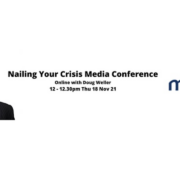
 By
By 